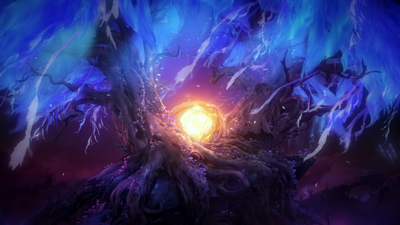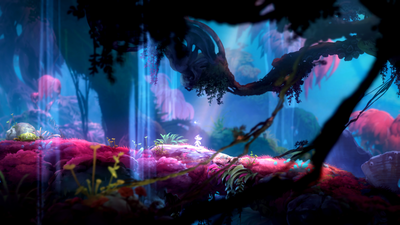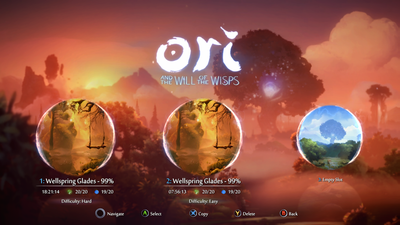Ori and the Will of the Wisps
Ori and the Will of the Wisps was released on March 10, 2020 — one day before many in the United States were put under stay-at-home orders to slow the spread of COVID-19. In the following months, our leaders abdicated their responsibility to coordinate a comprehensive response as the non-essential of us remained at home, wringing our hands and feeling powerless to stop our world from slipping into shambles. So when Ori opened with Naru, Gumo, and Ori working to restore Ku — a young owl with a malformed wing — my emotions were immediately invested. When the first major chapter involved ridding a historic watermill/library of a corrupted monster poisoning the water, my determination was fixed. And when Grom asked Ori “Want to make [the Wellspring Glades] a better place?” I nearly shouted “yes!” at the screen. Beautiful graphics, slick gameplay, and huge improvements over the original game aside, Ori and the Will of the Wisps is a game about healing, restoration, and hope — three things that run at a high premium in today’s world.

One more philosophical point before moving on to gameplay: I was pleased to see the thought given to the nature of evil and the role of violence in resisting it. While killing corrupted creatures is commonplace in the Ori series, there is also a consistent gravity around death and loss. This sequel explores these themes more thoroughly than the original. Without giving specifics away, only one enemy boss is actually murdered (and, interestingly, not by Ori). Moreover, the main antagonist is one that deserves the player’s hate and empathy equally, as summed up in this bit of dialogue:
I heard what happened to your friend, and I am sorry. Sorry for your friend, and for the one that hurt her. Nothing’s fouler than when the strong hurt the weak.
— Tokk, Ori and the Will of the Wisps
There’s a “we hurt ourselves when we hurt others” in here that’s revisited later in the game, when a character who once wanted the warmth of the light rejects it and chooses instead to remain isolated in darkness. I was left with the impression that this was an emotionally heavier fate than death.

In terms of gameplay and design, Ori and the Will of the Wisps surpasses its predecessor (Ori and the Blind Forest) in every way, and then some. In short, this is a must-play if you liked the original, and is the place you should start if you’re new to the series. Much has already been written about these improvements, like how Moon Studios created entirely new technologies to fit its beautifully crafted 3D assets in a 2D world. The world is filled with expressive characters, vibrant and responsive foliage, and gorgeous foreground/background effects that express depth. Role-playing elements give players newfound choice over Ori’s evolution. The boss fights blend the newly fluid combat system with the series' emblematic choreographed escape sequences. Gareth Coker returns with a triumph of a soundtrack that is deeply integrated with the rest of the game’s design.

Improved replayability deserves its own treatment. In Ori and the Blind Forest, collectibles were limited to Life and Energy Cells that increase the amount of health and ability energy Ori has, respectively. After finishing the main story, achievements and 100%-ing the game are the only incentives for finding all these secrets. In Ori and the Will of the Wisps, however, side quests and new collectibles give meaning to the secret hunting. With Gorlek Ore that Ori collects, Grom builds new structures in the Wellspring Glades for Moki to live in. Tolek plants Seeds that synergize with Ori’s abilities to make new areas of the Glades accessible. Ability Shards unlock useful augmentations of Ori’s abilities. Hardcore fans can take on the “*-less run,” requiring a complete run in under 4 hours without dying, spending Spirit Light, or equipping shards. These goals enhance the actual play experience, greatly improving the replay value.
Bugs
In what is otherwise an pristine and polished experience, Ori and the Will of the Wisps has several frustrating bugs:
- Spirit Charge is a mid-game ability whose primary purpose is to toss projectiles that fall back down, allowing Ori to Bash off of them and reach new heights. The “Spirit Rocket” bug causes all charges to instead fire off like missiles, happily ignoring gravity and stranding Ori without a lift. Thankfully, this bug seems to fix itself after a full game quit-and-restart.
- There were occasional rendering issues. After a long play session, the game would freeze and lag (again, quitting and restarting seemed to fix the problem). Later, after unlocking the Launch ability, Ori seemingly could move faster than the game could handle: Ori could Launch off-screen without the camera following, and once the camera caught up the environment occasionally wouldn’t render.
- Even after 100%-ing a run (and getting the corresponding achievements), the Energy Cell counter stays at 19/20, capping the progress tracker at 99% complete. This is uniquely maddening for people like me who live for the 100% completion.
